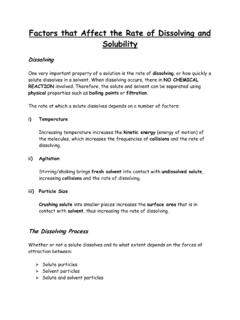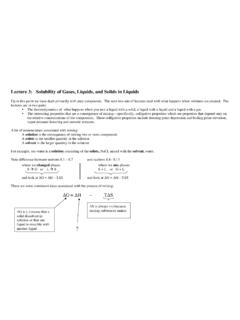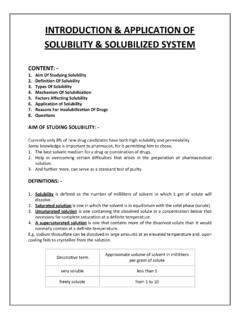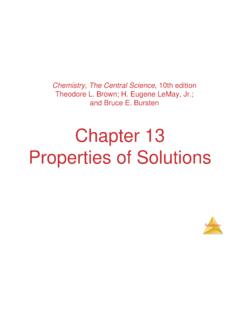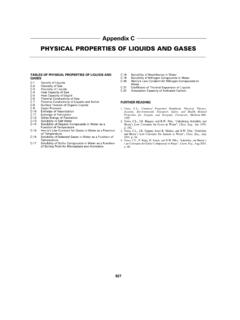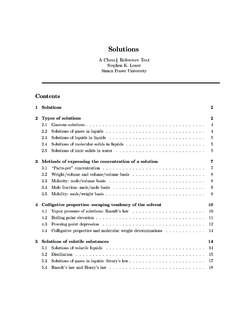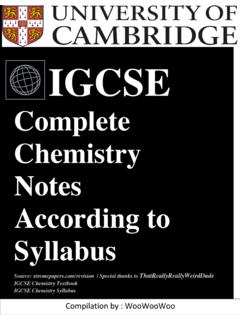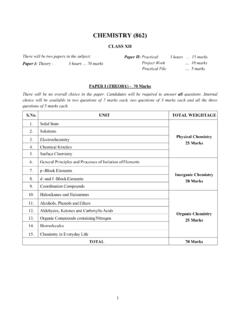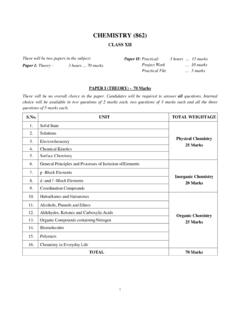Transcription of Class XII CHEMISTRY - KVS
1 1 | P a g e KENDRIYA VIDYALAYA SANGATHAN REGIONAL OFFICE, RAIPUR STUDENT SUPPORT MATERIAL (CAPSULES AND CASE-STUDY BASED QUESTIONS) Class XII CHEMISTRY SESSION 2020-21 2 | P a g e STUDENT SUPPORT MATERIAL INSPIRATION Ms. CHANDANA MANDAL, Deputy Commissioner, KVS RO Raipur. Sh. MISHRA, Assistant Commissioner, KVS RO Raipur. Smt. BIRJA MISHRA, Assistant Commissioner, KVS RO Raipur. MENTOR Sh. J. PRASAD , Principal, Kendriya Vidyalya Dongargarh. CONTENT DEVELOPMENT TEAM Smt. M. SHARDA RAO, PGT CHEMISTRY , KV NTPC Korba. Smt. FARHANA KHAN, PGT CHEMISTRY , KV BMY Bhilai. Sh. SANTOSH KUMAR CHAINI, PGT CHEMISTRY , KV Raigarh. Sh. WASIM KHAN, PGT CHEMISTRY , KV Dongargarh.
2 Sh. RUDRAKANT JHA, PGT CHEMISTRY , KV Raipur. Sh. JAIRAM KHUTE, PGT CHEMISTRY , KV Kusmunda Korba. Sh. VIJAY KUMAR SAHU, PGT CHEMISTRY , KV Baikunthpur. Sh. MANISH KUMAR GAUTAM, PGT CHEMISTRY , KV Jhagrakhand. Sh. PIYUSH KUMAR, PGT CHEMISTRY , KV Chirimiri. Sh. SHIVSHANKAR MATE, PGT CHEMISTRY , KV Dantewada. TEAM FOR EDITING, COMPILATION AND PREPRATION OF E-BOOK Sh. WASIM KHAN, PGT CHEMISTRY , KV Dongargarh. Sh. ABHISHEK BHASKAR, Computer Instructor, KV Dongargarh. 3 | P a g e CHEMISTRY Class XII INDEX Sr. No. Particulars Page No. 1 Details of Revised Syllabus (2020-21)- 4 - 5 2 Deleted Topics for Session 2020-21 6 - 10 3 solid State 11 - 14 4 Solutions 14 - 21 5 Electro CHEMISTRY 21 - 24 6 Chemical Kinetics 24 28 7 Surface CHEMISTRY 28 - 32 8 p-Block Elements 32 - 41 9 d & f- Block Elements 41 - 47 10 Co-ordination Compounds 47 53 11 Haloalkanes and Haloarenes 53 58 12 Alcohols, Phenols and Ethers 59 65 13 Aldehydes.
3 Ketones and Carboxylic Acids 66 83 14 Amines 83 94 15 Bio Molecules 94 99 16 Sample Paper 1 100 112 17 Sample Paper 2 113 124 18 Sample Paper 3 125 143 19 Sample Paper 4 144 153 20 Sample Paper 5 154 169 21 General Revision Plan 170 22 Special Revision Plan 171 172 23 Special Material for Organic CHEMISTRY 173 195 Index 4 | P a g e Unit I: solid State 8 Periods SYLLABUS CHEMISTRY Class -XII Classification of solids based on different binding forces: molecular, ionic, covalent and metallic solids, amorphous and crystalline solids (elementary idea). Unit cell in two dimensional and three dimensional lattices, calculation of density of unit cell, packing in solids, packing efficiency, voids, number of atoms per unit cell in a cubic unit cell, point defects.
4 Unit II: Solutions 8 Periods Types of solutions, expression of concentration of solutions of solids in liquids, solubility of gases in liquids, solid solutions, Raoult's law, colligative properties - relative lowering of vapor pressure, elevation of boiling point, depression of freezing point, osmotic pressure, determination of molecular masses using colligative properties. Unit III: Electrochemistry 7 Periods Redox reactions, EMF of a cell, standard electrode potential, Nernst equation and its application to chemical cells, Relation between Gibbs energy change and EMF of a cell, conductance in electrolytic solutions, specific and molar conductivity, variations of conductivity with concentration, Kohlrausch's Law, electrolysis.
5 Unit IV: Chemical Kinetics 5 Periods Rate of a reaction (Average and instantaneous), factors affecting rate of reaction: concentration, temperature, catalyst; order and molecularity of a reaction, rate law and specific rate constant, integrated rate equations and half-life (only for zero and first order reactions). Unit V: Surface CHEMISTRY 5 Periods Adsorption - physisorption and chemisorption, factors affecting adsorption of gases on solids, colloidal state: distinction between true solutions, colloids and suspension; lyophilic, lyophobic, multi-molecular and macromolecular colloids; properties of colloids; Tyndall effect, Brownian movement, electrophoresis, coagulation. Unit VII:p-Block Elements 7 Periods Group -15 Elements: General introduction, electronic configuration, occurrence, oxidation states, trends in physical and chemical properties; Nitrogen preparation properties and uses; compounds of Nitrogen: preparation and properties of Ammonia and Nitric Acid.
6 Group 16 Elements: General introduction, electronic configuration, oxidation states, occurrence, trends in physical and chemical properties, dioxygen: preparation, properties and uses, classification of Oxides, Ozone, Sulphur -allotropic forms; compounds of Sulphur: preparation properties and uses of Sulphur-dioxide, Sulphuric Acid: properties and uses; Oxoacids of Sulphur (Structures only). Group 17 Elements: General introduction, electronic configuration, oxidation states, occurrence, trends in physical and chemical properties; compounds of halogens, Preparation, properties and uses of Chlorine and Hydrochloric acid, interhalogen compounds, Oxoacids of halogens (structures only). 5 | P a g e Group 18 Elements: General introduction, electronic configuration, occurrence, trends in physical and chemical properties, uses.
7 Unit VIII: d and f Block Elements 7 Periods General introduction, electronic configuration, occurrence and characteristics of transition metals, general trends in properties of the first-row transition metals metallic character, ionization enthalpy, oxidation states, ionic radii, color, catalytic property, magnetic properties, interstitial compounds, alloy formation. Lanthanoids - Electronic configuration, oxidation states and lanthanoid contraction and its consequences. Unit IX: Coordination Compounds 8 Periods Coordination compounds - Introduction, ligands, coordination number, color, magnetic properties and shapes, IUPAC nomenclature of mononuclear coordination compounds. Bonding, Werner's theory, VBT, and CFT.
8 Unit X: Haloalkanes and Haloarenes. 9 Periods Haloalkanes: Nomenclature, nature of C X bond, physical and chemical properties, optical rotation mechanism of substitution reactions. Haloarenes: Nature of C X bond, substitution reactions (Directive influence of halogen in monosubstituted compounds only). Unit XI: Alcohols, Phenols and Ethers 9 Periods Alcohols: Nomenclature, methods of preparation, physical and chemical properties (of primary alcohols only), identification of primary, secondary and tertiary alcohols, mechanism of dehydration. Phenols: Nomenclature, methods of preparation, physical and chemical properties, acidic nature of phenol, electrophilic substitution reactions, uses of phenols.
9 Ethers: Nomenclature, methods of preparation, physical and chemical properties, uses. Unit XII: Aldehydes, Ketones and Carboxylic Acids 10 Periods Aldehydes and Ketones: Nomenclature, nature of carbonyl group, methods of preparation, physical and chemical properties, mechanism of nucleophilic addition, reactivity of alpha hydrogen in aldehydes, uses. Carboxylic Acids: Nomenclature, acidic nature, methods of preparation, physical and chemical properties; uses. Unit XIII: Amines 7 Periods Amines: Nomenclature, classification, structure, methods of preparation, physical and chemical properties, uses, identification of primary, secondary and tertiary amines. Unit XIV: Biomolecules 8 Periods Carbohydrates - Classification (aldoses and ketoses), monosaccharides (glucose and fructose), D-L configuration Proteins -Elementary idea of - amino acids, peptide bond, polypeptides, proteins, structure of proteins - primary, secondary, tertiary structure and quaternary structures (qualitative idea only), denaturation of proteins.
10 Nucleic Acids: DNA and | P a g e Class XII - CHEMISTRY DETAILS OF REVISED SYLLABUS 2020-21 7 | P a g e 8 | P a g e 9 | P a g e Unit 10: Haloalkanes and Haloarenes Haloalkanes: Nomenclature, nature of C X bond, physical and chemical properties, optical rotation mechanism of substitution reactions. Haloarenes: Nature of C X bond, substitution reactions (Directive influence of halogen in monosubstituted compounds only). Uses and environmental effects of dichloromethane, triChloromethane, tetrachloromethane, iodoform, freons, DDT. 1. Uses and environmental effects of dichlorometha ne, trichlorometha ne, tetrachloromet hane, iodoform, freons, DDT. Haloalkanes: Nomenclature, nature of C-X bond.
![Class - XII Multiple Choice Question Bank [MCQ ] Term I](/cache/preview/c/9/8/8/1/a/2/8/thumb-c9881a28c229f817f59fa2c1b29649a9.jpg)
![Class - XII Multiple Choice Question Bank [MCQ ] Term I](/cache/preview/d/5/7/4/9/b/0/1/thumb-d5749b019eaaa21f47e8fe547d0111c8.jpg)
![Class - XII Multiple Choice Question Bank [MCQ ] Term I ...](/cache/preview/2/2/d/1/9/1/7/6/thumb-22d19176a1dd6102cff77672154d578a.jpg)
![Class - XII Multiple Choice Question Bank [MCQ ] Term](/cache/preview/9/8/c/e/d/c/1/0/thumb-98cedc1076e6565bb46f2cbd68251d1a.jpg)

![Class - XII Multiple Choice Question Bank [MCQ ] Term I](/cache/preview/c/a/7/f/9/4/c/2/thumb-ca7f94c25e222ce280212b074d82de1f.jpg)
![Class - XII Multiple Choice Question Bank [MCQ ] Term](/cache/preview/4/3/0/0/b/2/b/5/thumb-4300b2b57aa6bc47be8b515b63a28222.jpg)
![Class - XII Multiple Choice Question Bank [MCQ ] Term I](/cache/preview/4/8/7/7/e/0/6/d/thumb-4877e06df4cbcb63907b1b0bd8a8ba65.jpg)
![Class - XII Multiple Choice Question Bank [MCQ ] Term I ...](/cache/preview/6/b/f/b/7/f/d/9/thumb-6bfb7fd939feb6eb499b3aa869a2a6ac.jpg)
![Class - XII Multiple Choice Question Bank [MCQ ] Term I](/cache/preview/f/7/d/c/0/b/9/b/thumb-f7dc0b9b16c9fbe241756cd4eee3ae68.jpg)
